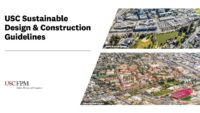Buro Happold’s Kathleen Hetrick Among Authors for Book on Regenerative Materials

Photo courtesy of Buro Happold
The current materials economy won’t last for long. Not if these 20-plus experts and advocates are right.
In a new book aptly presenting their work as a “movement” rather than a migration or mere marginal improvement, the visionaries etch out their vision of a bold future where buildings are made with regenerative materials that make our homes, offices, structures and everyday products more just, healthier and safer for the future of the planet.
Titled The Regenerative Materials Movement: Dispatches from Practitioners, Researchers and Advocates, the new book shares “real-world stories, research, revelations and insights in a series of dispatches” that bring potentially murky concepts into stark relief. The choice for architects, builders and owners is to either use circular, self-renewing materials or watch planetary problems blow up.
Published by the Ecotone Publishing imprint of International Living Future Institute, a group committed to “cultivating a society that is socially just, culturally rich and ecologically restorative,” The Regenerative Materials Movement is essential reading for those committed to sustainable design and reversing climate change. Among the authors is Kathleen Hetrick, an expert with Buro Happold, alongside MASS Design, Harvard’s Heather Henriksen, Google’s Robin Bass and other notables, like Don Davies and William Browning.
In Part III of the authoritative tome, Hetrick speaks to supply chains — which she sets out to prove are “the key to social equity, human health and climate goals.”
“For carcinogenic chemicals like polyvinyl chloride, the harm comes in many forms: from the climate change cost of cracking ethylene to the production and mining of the mercury, asbestos and PFAS needed for synthesis; from the occupational health hazards of vinyl chloride exposure to the train derailment in East Palestine, Ohio; from fake-wood flooring in our children’s nurseries to labor issues half a world away,” Hetrick wrote.
PVC occurs in everything from toys and flooring to consumer goods and medical equipment. “When burned, PVC has been found to emit hazardous substances, such as dioxins, which are known carcinogens, into the air,” Hetrick explained. “Unsurprisingly, firefighters and other first responders, who are chronically exposed to burning chlorinated materials and other pollutants, suffer a 14 percent higher risk of dying from cancer than the general public.” And the burning of plastic piping leaches harmful pollutants, like benzene, into drinking supplies — as caused by recent wildfires in Northern California communities.

Photo courtesy of Buro Happold
Other chapters in ILFI’s Regenerative Materials Movement support Hetrick’s focus on supply chains, exposing both challenges and solutions for “embodied suffering” in imported products (by Sharon Prince of Grace Farms) to “Red List” chemicals found hidden in many manufactured materials (by ILFI’s Hannah Ray).
The 21-chapter, 248-page, full-color book was released Sept. 7 and costs about $45. Find out more here.
Looking for a reprint of this article?
From high-res PDFs to custom plaques, order your copy today!








